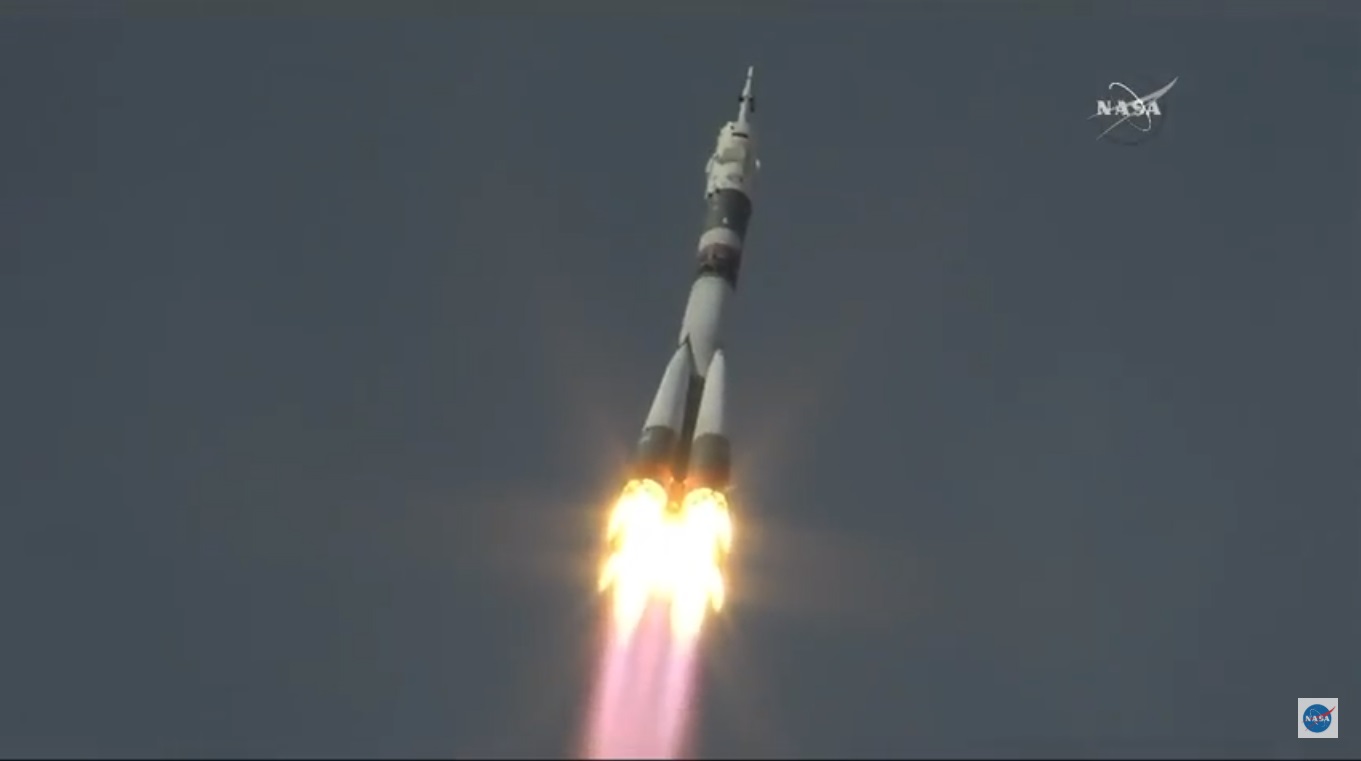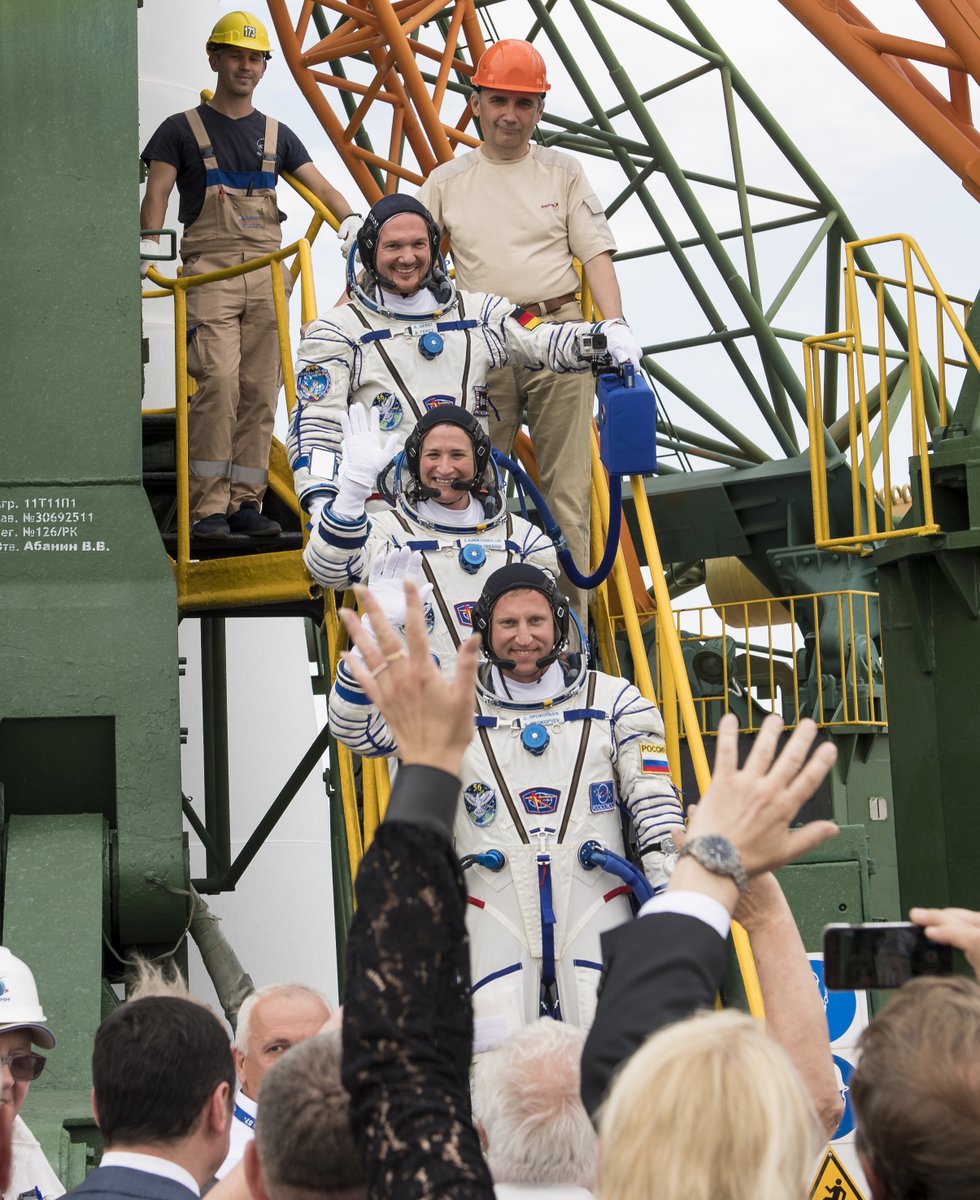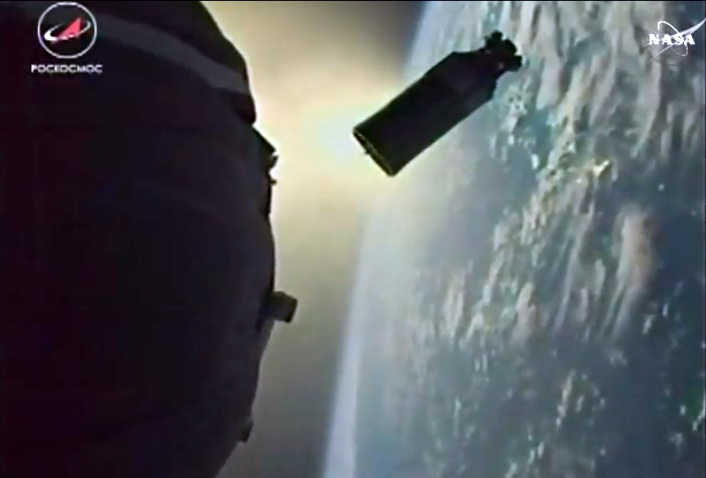Liftoff! International Crew Launches Toward Space Station
BAIKONUR, Kazakhstan — Three space fliers have just embarked on a two-day journey to the International Space Station (ISS).
NASA's Serena Auñón-Chancellor, cosmonaut Sergey Prokopyev and European Space Agency astronaut Alexander Gerst launched aboard a Russian Soyuz MS-09 spacecraft today (June 6) from Baikonur Cosmodrome here in this Central Asian nation. The Soyuz rocket carrying their spacecraft lifted off at 7:12 a.m. EDT (1112 GMT; 5:12 p.m. local Kazakhstan time), kicking up dust under partly cloudy skies.
A crowd of more than 200 journalists and tourists cheered from their vantage point approximately 0.9 miles (1.5 kilometers) from the launch pad. However, Canadian astronaut David Saint-Jacques – a member of the backup crew – remained silent for the first minute after launch. It’s one of the most risky parts of the mission, and he had just spent the better part of the day ensuring that the three crewmates were ready to take on anything that might happen. [Related: Follow Elizabeth Howell's Russian Rocket Launch Road Trip!]
Saint-Jacques broke the silence to explain contrails appearing behind the rocket in the sky – "It's going past the speed of sound," he said – but remained focused on the rocket until it disappeared into the blue sky. In announcements, Russian space agency Roscosmos said the launch was normal. The three astronauts on board are scheduled to arrive at the ISS on Friday (June 8).

While Gerst has flown in space before, this will be the first mission for both Prokopyev and Auñon-Chancellor. Gerst was part of the Expedition 40/41 ISS crew between May and November 2014, when he performed a single spacewalk with NASA astronaut Reid Wiseman. Gerst will also command Expedition 57. Prokopyev, a former commander of a Russian Tu-160 bomber squadron, was selected as a test cosmonaut candidate in 2010. [Russia's Space Traditions! 14 Things Every Cosmonaut Does for Launch]
Auñon-Chancellor, a former astronaut flight surgeon before her selection in 2009, told reporters yesterday that every astronaut has a different perspective of spaceflight that they try to show in social media. For her, it will be focusing on the 300 or so experiments the crew will perform during their six months in space, "so people understand the science [we perform] when we are in orbit," she said.
Today's launch coincidentally takes place on an important day for Russia; June 6 is the anniversary of the birth of Alexander Pushkin, who is considered to be one of the most important poets in Russian history. The liftoff also happened close to a major Russian space anniversary: Valentina Tereshkova, the first woman in space, launched from Baikonur almost exactly 55 years ago, on June 16, 1963. Tereshkova attended a ceremonial crew walkout earlier today, walking just feet away from the attending reporters.
Get the Space.com Newsletter
Breaking space news, the latest updates on rocket launches, skywatching events and more!
It's been a busy few days of activity at the ISS, as three crew members just departed from there on Sunday (June 3). Russian cosmonaut Anton Shkaplerov, Norishige "Neemo" Kanai of the Japan Aerospace Exploration Agency (JAXA) and astronaut Scott "Maker" Tingle of NASA landed in Russia's Soyuz MS-07 spacecraft in the Kazakhstan desert at 8:39 a.m. EDT (1239 GMT or 6:39 p.m. local Kazakh time).
Two rookies and a spacewalk
While Gerst has flown in space before, this will be the first mission for both Prokopyev and Auñon-Chancellor. Gerst was part of the Expedition 40/41 ISS crew between May and November 2014, when he performed a single spacewalk with NASA astronaut Reid Wiseman. Gerst will also command Expedition 57. Prokopyev, a former commander of a Russian Tu-160 bomber squadron, was selected as a test cosmonaut candidate in 2010.
Auñon-Chancellor, a former astronaut flight surgeon before her selection in 2009, told reporters yesterday that every astronaut has a different perspective of spaceflight that they try to show in social media. For her, it will be focusing on the 300 or so experiments the crew will perform during their six months in space, “so people understand the science [we perform] when we are in orbit,” she said.
NASA picked Auñón-Chancellor— a former astronaut flight surgeon — as an astronaut candidate in 2009. She has two NASA Extreme Environment Mission Operations missions under her belt; she lived in the Aquarius undersea laboratory near Key West, Florida, for stretches in both 2012 and 2015.

Auñón-Chancellor is a replacement for Jeanette Epps, who was originally supposed to fly on this mission. NASA announced the change in January but has not given any details about why the switch was made. Epps, who would have been the first-ever African-American ISS crewmember, will still be considered for future space missions, agency officials have said. [Expedition 56: The Space Station Mission in Photos]
Today's launch coincidentally takes place on an important day for Russia; June 6 is the anniversary of the birth of Alexander Pushkin, who is considered to be one of the most important poets in Russian history. The liftoff also happened close to a major Russian space anniversary: Valentina Tereshkova, the first woman in space , launched from Baikonur almost exactly 55 years ago, on June 16, 1963. Tereshkova attended a ceremonial crew walkout earlier today, walking just feet away from the attending reporters.
It’s been a busy few days of activity at the ISS, as three crew members just departed from there on Sunday (June 3). Russian cosmonaut Anton Shkaplerov, Norishige "Neemo" Kanai of the Japan Aerospace Exploration Agency (JAXA) and astronaut Scott "Maker" Tingle of NASA landed in Russia's Soyuz MS-07 spacecraft in the Kazakhstan desert at 8:39 a.m. EDT (1239 GMT or 6:39 p.m. local Kazakh time).
In a new twist, the Soyuz that launched Auñón-Chancellor, Gerst and Prokopyev also carried a new camera that beamed spectacular live views from space as the rocket soared into orbit. In one striking image, the camera caught a farewell glimpse of the Soyuz's upper stage as it fell away from the MS-09 space capsule.

The new crew will have just a few days to get adjusted to space before a planned spacewalk on June 14. Arnold and Feustel will install equipment to help upcoming U.S. commercial crew vehicles align themselves with the international docking adapter on the Harmony module of the ISS. The astronauts will install brackets and high-definition cameras on Harmony that will assist with the dockings; the cameras will also be used for wireless data networking with experiments on the ISS, NASA officials have said.
The next launch to the ISS is expected to be a SpaceX Dragon resupply mission. A Falcon 9 rocket carrying an uncrewed Dragon is expected to launch no earlier than June 28 from NASA's Kennedy Space Center in Florida.
Calls for lunar program funding
Yesterday (June 5), Gerst made comments about what’s next at the ISS at a crowded press conference at the Cosmonaut Hotel, where the astronauts were in quarantine in the hours before the launch. Gerst and his crewmates sat behind a glass wall, talking to approximately 150 journalists – mainly from Russia and Germany.
When one reporter asked about the 20th anniversary of the ISS this year, Gerst reminded the audience that the orbiting complex required decades of development even before the first module launched in 1998. He said that if international partners want a space program after the ISS concludes, they need to plan in earnest now – and to urge young people to take careers in science, engineering, technology and math (STEM).
"It pays out to go to school and to start to become a scientist or engineer – boy or girl, it doesn't matter," Gerst said.
His comments come as the ISS program sits at a crossroads. NASA has a tentative budget before Congress that would conclude funding for the ISS in 2024. Presumably, the agency would then focus on its Lunar Orbiting Platform Gateway, a space station near the moon. The Trump administration has tasked NASA to go back to the moon in the 2020s before going to Mars, marking yet another policy shift for an agency that was focused on Mars under the Obama administration. But the European Space Agency’s director-general, Johann-Dietrich Wörner, praised the new policy.
"For me, personally, the moon is very clearly the next destination. So what the Americans are proposing ... that is a good idea where we can join forces in international activities and international cooperation," Wörner said in a press conference earlier today at the Central Hotel, where the European Space Agency press corps is staying.
For Europe, the mood in past days has been one of celebration, including many tweets and social media posts from Germans. Most of the ESA-led press corps here (which Space.com was a part of) is German; the VIP delegation with ESA included former German astronauts Sigmund Jähn (the first German in space, when his region was a part of East Germany), Reinhold Ewald and Thomas Reiter.
"You can imagine that [Gerst's] function as a commander is combined with a high level of responsibility," Reiter told Space.com in a brief phone interview yesterday. He spoke in between events Reiter attended here in Baikonur, including visiting the Baikonur Museum with the other astronauts.
"Beyond the normal tasks that astronauts have to fulfill,” he added, “in the sense of the scientific program and the station, the commander has to take care of the crew in total, and know the picture of how the work is progressing during the day and the week."
Reiter said Germany is "really happy and extremely proud" that Gerst – who is on his second mission since 2014 – will be the second European commander of the ISS. Germany's human space program has evolved considerably since Jähn flew to space in 1978 as part of the Russian Interkosmos program. German astronauts began with low levels of responsibility in space missions – as payload specialists, for example – and over the decades, built up enough experience to take on more senior roles.
Gerst's command, Reiter added, "shows beyond all the technical and operational implications, there is a political signal that the [ISS] is a real co-operation on an even level." He warned that Germany has financial constraints when it comes to funding space, so the country is focused on funding missions with practical applications on Earth, such as creating materials. But Reiter said he is hoping for more exploration. "My wish would be to see humans returning to the surface of the moon in the next decade; I would expect it would happen in the second half," he said.
Editor's note: Elizabeth Howell is a freelance space reporter covering the launch and docking of Expedition 56 for Space.com from Baikonur Coosmodrome and Moscow. You can follow her epic Russian rocket launch road trip here. This story has been updated with more details from the successful Soyuz launch.
Follow us @Spacedotcom, Facebook or Google+. Originally published on Space.com.
Join our Space Forums to keep talking space on the latest missions, night sky and more! And if you have a news tip, correction or comment, let us know at: community@space.com.

Elizabeth Howell (she/her), Ph.D., was a staff writer in the spaceflight channel between 2022 and 2024 specializing in Canadian space news. She was contributing writer for Space.com for 10 years from 2012 to 2024. Elizabeth's reporting includes multiple exclusives with the White House, leading world coverage about a lost-and-found space tomato on the International Space Station, witnessing five human spaceflight launches on two continents, flying parabolic, working inside a spacesuit, and participating in a simulated Mars mission. Her latest book, "Why Am I Taller?" (ECW Press, 2022) is co-written with astronaut Dave Williams.









